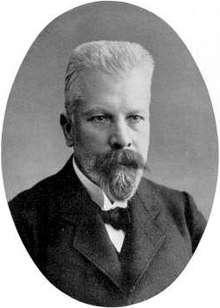Eduard Buchner
Eduard Buchner (20 May 1860 – 13 August 1917) was a German chemist and zymologist, awarded the 1907 Nobel Prize in Chemistry for his work on fermentation.
Eduard Buchner | |
|---|---|
 | |
| Born | 20 May 1860 |
| Died | 13 August 1917 (aged 57) Focșani, Romania |
| Cause of death | Killed in action |
| Nationality | Germany |
| Alma mater | University of Munich |
| Known for | Mannich reaction |
| Awards | Nobel Prize in Chemistry (1907) |
| Scientific career | |
| Fields | Biochemistry |
| Institutions | University of Berlin University of Kiel University of Munich |
| Doctoral advisor | Theodor Curtius |
Biography
Early years
Buchner was born in Munich to a physician and Doctor Extraordinary of Forensic Medicine. His older brother was Hans Ernst August Buchner.[1] In 1884, he began studies of chemistry with Adolf von Baeyer and of botany with Carl Nägeli, at the Botanic Institute in Munich. After a period working with Hermann Emil Fischer in Erlangen, Buchner was awarded a doctorate from the University of Munich in 1888 under Theodor Curtius. He died in the Battle of Mărășești and is buried in the cemetery of German soldiers from Focșani, Romania.[2]
Research
The experiment for which Buchner won the Nobel Prize consisted of producing a cell-free extract of yeast cells and showing that this "press juice" could ferment sugar. This dealt yet another blow to vitalism by showing that the presence of living yeast cells was not needed for fermentation. The cell-free extract was produced by combining dry yeast cells, quartz and kieselguhr and then pulverizing the yeast cells with a pestle and mortar. This mixture would then become moist as the yeast cells' contents would come out of the cells. Once this step was done, the moist mixture would be put through a press and the resulting "press juice" had glucose, fructose, or maltose added and carbon dioxide was seen to evolve, sometimes for days. Microscopic investigation revealed no living yeast cells in the extract. Buchner hypothesized that yeast cells secrete proteins into their environment in order to ferment sugars, but it was later found that fermentation occurs inside the yeast cells. Maria Manasseina claimed to have discovered free-cell fermentation a generation earlier than Buchner.[3]
Though it is believed by some that the Büchner flask and the Büchner funnel are named for him, they are actually named for the industrial chemist Ernst Büchner.[4]
Buchner received the Nobel Prize in Chemistry in 1907.
Personal life
Buchner married Lotte Stahl in 1900. At the outbreak of the First World War he volunteered and rose to the rank of Major commanding a munition-transport unit on the western and then eastern front. In March 1916 he returned the University of Wurzburg. In April 1917 he volunteered again. On 11 August 1917, while stationed at Focșani, Romania, he was hit by a shell fragment and died two days later. .[5]
Publications
- Eduard Buchner (1897). "Alkoholische Gährung ohne Hefezellen (Vorläufige Mitteilung)". Berichte der Deutschen Chemischen Gesellschaft. 30: 117–124. doi:10.1002/cber.18970300121.
- Eduard Buchner, Rudolf Rapp (1899). "Alkoholische Gährung ohne Hefezellen". Berichte der Deutschen Chemischen Gesellschaft. 32 (2): 2086–2094. doi:10.1002/cber.189903202123.
- Robert Kohler (1971). "The background to Eduard Buchner's discovery of cell-free fermentation". Journal of the History of Biology. 4 (1): 35–61. doi:10.1007/BF00356976. PMID 11609437.
- Robert Kohler (1972). "The reception of Eduard Buchner's discovery of cell-free fermentation". Journal of the History of Biology. 5 (2): 327–353. doi:10.1007/BF00346663. PMID 11610124.
References
- Asimov, Asimov's Biographical Encyclopedia of Science and Technology 2nd Revised edition
- Ukrow, Rolf (2004). Nobelpreisträger Eduard Buchner (1860 – 1917) Ein Leben für die Chemie der Gärungen und - fast vergessen - für die organische Chemie (German). Berlin.
- Cornish-Bowden, Athel (1999). "The Origins of Enzymology". The Biochemist. 19 (2): 36–38. Retrieved 2017-10-18.
- Jensen, William (2006). "The Origins of the Hirsch and Büchner Vacuum Filtration Funnels". Journal of Chemical Education. 83 (9): 1283. Bibcode:2006JChEd..83.1283J. doi:10.1021/ed083p1283. Archived from the original on 2009-08-29.
- Ukrow, Rolf (2004). Nobelpreisträger Eduard Buchner (1860 – 1917) Ein Leben für die Chemie der Gärungen und - fast vergessen - für die organische Chemie (German). Berlin.
External links
- Works by or about Eduard Buchner at Internet Archive
- Eduard Buchner on Nobelprize.org including the Nobel Lecture, December 11, 1907 Cell-Free Fermentation
- Buchner, Eduard (1897). "Alcoholic Fermentation Without Yeast Cells". Ber. Dtsch. Chem. Ges. 30: 117–124. doi:10.1002/cber.18970300121. Archived from the original on 2006-08-19. (English translation of Buchner's "Alkoholische Gährung ohne Hefezellen")
